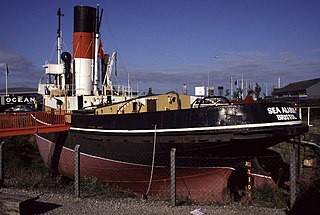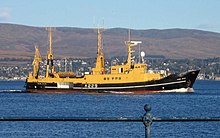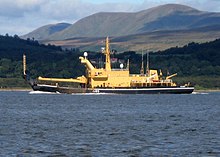Background
The Royal Maritime Auxiliary Service merged with the former Port Auxiliary Service in 1976 to form a component of His Majesty's Naval Service that was known as marine services. Marine services existed to support the operations of the Royal Navy, Royal Marines and Royal Fleet Auxiliary.
In the 1990s, marine services were put out to commercial tender by the Ministry of Defence Warship Support Agency (now absorbed into the Defence Equipment and Support organisation) and by 1996, all tugs, lifting craft, various tenders and management of HMNB Devonport, Portsmouth and Clyde were operated by Serco Denholm. [2]
By the mid 2000s, it was decided that the Royal Maritime Auxiliary Service would no longer provide marine services to HM Naval Service, and it would instead be delivered under a Private Finance Initiative instead. Serco were quickly declared preferred bidders and the RMAS was disbanded on 31 March 2008. [3] [4]

His Majesty's Naval Base, Clyde, primarily sited at Faslane on the Gare Loch, is one of three operating bases in the United Kingdom for the Royal Navy. It is the navy's headquarters in Scotland and is best known as the home of Britain's nuclear weapons, in the form of nuclear submarines armed with Trident missiles.

His Majesty's Naval Service is the United Kingdom's naval warfare and maritime service. It consists of the Royal Navy, Royal Marines, Royal Fleet Auxiliary, Royal Naval Reserve, Royal Marines Reserve and Naval Careers Service. The Naval Service as a whole falls under the command of the Navy Board, which is headed by the First Sea Lord. This position is currently held by Admiral Sir Ben Key. The Defence Council delegates administration of the Naval Service to the Admiralty Board, chaired by the Secretary of State for Defence.
SD Faithful is a Twin Tractor Unit Tug operated by Serco Marine Services in support of the United Kingdom's Naval Service. The ship was formerly operated by the Royal Maritime Auxiliary Service until its disbandment in March 2008. The vessel was originally built for the Royal Maritime Auxiliary Service in 1985.

The Royal Naval Auxiliary Service (RNXS) was a uniformed, unarmed, civilian volunteer service, administered and trained by the Royal Navy to operate in the ports and anchorages of the United Kingdom in an emergency. Although the abbreviated title would logically have been RNAS this abbreviation had long been taken by the various Royal Naval Air Stations, so RNXS it was. It maintained training units, and vessels at most major ports in the UK. and was formed in 1963 from the amalgamation of the Royal Naval Mine-watching Service (RNMWS) and Admiralty Ferry Crew Association in response to the perceived nuclear threat to British ports. The service was disbanded on 31 March 1994 due to Ministry of Defence (MOD) cuts. Most vessels from its fleet were transferred to the Royal Navy or sold, with the exception of XSV Loyal Volunteer, which was struck by a ro-ro ferry while berthed in Ipswich Harbour and was later scrapped.

SD Salmoor was a Sal-Class mooring and salvage vessel working at HMNB Clyde, and based at Great Harbour, Greenock. She was originally operated by the Royal Maritime Auxiliary Service, but after the organisations disbandment in March 2008 she was operated by Serco Marine Services.

SD Colonel Templer is an acoustic research vessel, renamed Seaway Endeavour in 2011 after she was sold to a Swedish shipping company. Between 1980 and 2011, she was in the service of the Royal Aircraft Establishment, the Royal Maritime Auxiliary Service and Serco Marine Services in support of the United Kingdom's Naval Service. Before 1980, Colonel Templer was known as MV Criscilla and worked as a stern trawler.

MT Deerhound is a Dog-class medium berthing tugboat built for the Royal Maritime Auxiliary Service (RMAS) in 1966 by Appledore Shipbuilders, Appledore, North Devon.
DMS Maritime, formerly Defence Maritime Services, is a company providing port services to the Australian Defence Force and Marine Unit. It is a subsidiary of Serco.

The Clovelly-class fleet tenders, also known as the Cartmel class, are a class of Royal Maritime Auxiliary Service boats built between 1967 and 1982. The class was named after villages and small towns in Great Britain. Six of the class, Clovelly, Ilchester, Instow, Invergordon, Ironbridge and Ixworth were equipped to act as diving tenders. Lydford was originally commissioned as A510 Loyal Governor, then renamed P252 Alert for service in Ulster until 1986.

Serco Marine Services is a Private Finance Initiative contract, with Serco Group, to deliver auxiliary services to His Majesty's Naval Service.
NI Mário Ruivo, previously known as NI Mar Portugal, is a research vessel of the Portuguese Institute of the Sea and the Atmosphere (IPMA).

RMAS Salmaster (A186) was a Sal-class mooring and salvage vessel completed in 1986 for the Royal Navy and initially operated by the Royal Maritime Auxiliary Service (RMAS). She was sold in 2001 into commercial ownership.

The Government Service Ensign is a defaced Blue Ensign flown by vessels owned by the British Ministry of Defence for which no other ensign is appropriate. It is most commonly seen flown by warships undergoing contractors' trials before being commissioned into the Royal Navy, and former Royal Maritime Auxiliary Service vessels now operated by Serco Denholm.

Admiralty tugs were tugboats built for and operated by the Royal Navy. These were vessels built to Admiralty specifications and in specific classes during the First and Second World Wars. They were built to meet the Royal Navy's demand for auxiliary vessels and to supplement the civilian tugs requisitioned by the Admiralty for war service.

The Felicity class is a class of water tractors operated by Serco Marine Services in support of the United Kingdom's Naval Service. Historically the vessels were operated by the Royal Maritime Auxiliary Service, disbanded in March 2008.
In 1989 the Royal Navy was under the direction of the Navy Department in the UK Ministry of Defence. It had two main commands, CINCFLEET and Naval Home Command.
Several ships of the British Royal Navy have borne the name Bustler:
This page is based on this
Wikipedia article Text is available under the
CC BY-SA 4.0 license; additional terms may apply.
Images, videos and audio are available under their respective licenses.




















